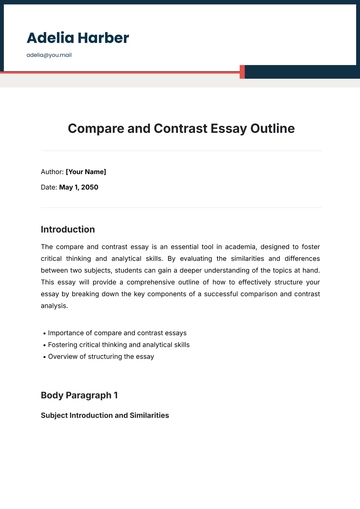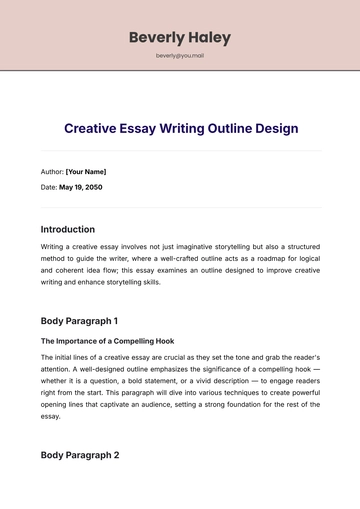Free Sample Expository Essay Outline

Author: [Your Name]
Date: March 11, 2050
Introduction
The expository essay is a genre of writing that seeks to explain, illuminate, or expose a particular topic. This type of essay provides facts rather than opinions and requires comprehensive research to present the content objectively. The purpose of an expository essay is to foremost inform, provide insight, and offer explanations that are logically structured. This essay serves to outline the essential components of a successful expository essay sequentially and engagingly.
Body Paragraph 1
Understanding the Prompt
The first step in crafting an effective expository essay is comprehending the prompt or subject matter thoroughly. This involves dissecting the question, identifying keywords, and ensuring you understand what is required. This step may include some preliminary research to evaluate the extent of information available on the topic.
For example, if the essay prompt is about "The Impact of Technology on Education," dissecting this could mean understanding the different technological advancements being referred to and identifying whether to focus on past, present, or future impacts. This foundational step sets the stage for the direction and scope of the essay.
Body Paragraph 2
Conducting Research
Once the topic is understood, the next vital step is conducting thorough research. Expository essays are inherently rooted in facts, requiring credible sources to support claims and assertions. This could involve using academic journals, books, reputable websites, and other scholarly resources. Research should cover various viewpoints to provide a balanced view of the subject matter.
For instance, when researching "The Impact of Technology on Education," consider diverse perspectives such as the benefits of digital learning, potential drawbacks, statistical data, and expert opinions. Taking notes and organizing this information will aid in forming a coherent and structured argument.
Body Paragraph 3
Structuring the Essay
An expository essay should be systematically organized to ensure clarity and flow. Begin with a clear thesis statement that outlines the main argument or focus of the essay. Each supporting paragraph should begin with a topic sentence that further develops the thesis, followed by evidence and examples explaining the point made. Transition sentences are crucial for maintaining flow between paragraphs and preserving the reader’s attention.
Continuing with our earlier example, structure the essay so that each paragraph explores a different aspect of technology’s impact on education – such as accessibility, interactivity, and personalized learning. Each section should connect back to the thesis, substantiating how technology contributes to or alters the educational landscape.
Conclusion
The conclusion is a crucial component of the expository essay, providing a chance to reinforce the thesis and ensure that every point raised is adequately addressed. Avoid introducing new information but instead, synthesize the main points discussed. Summarize how the evidence provided supports the thesis and reflect on the broader implications of the topic.
For example, the conclusion could return to the initial thesis on technology’s impact and highlight the transformative potential of digital tools in education, noting both opportunities and challenges ahead. This final paragraph should leave the reader with a clear understanding of the topic and the essay's overall argument.
In summary, crafting a coherent expository essay involves understanding the prompt, conducting exhaustive research, structuring the content logically, and concluding effectively to underscore the essay's primary objective of informing and explaining.
- 100% Customizable, free editor
- Access 1 Million+ Templates, photo’s & graphics
- Download or share as a template
- Click and replace photos, graphics, text, backgrounds
- Resize, crop, AI write & more
- Access advanced editor
Simplify your expository writing process with Template.net's Sample Expository Essay Outline Template. This editable and customizable outline lets you organize facts and ideas clearly for an informative essay. Featuring an editable structured format in our AI Editor Tool, it helps you craft compelling introductions, body paragraphs, and conclusions. Achieve polished and well-organized essays effortlessly.





























